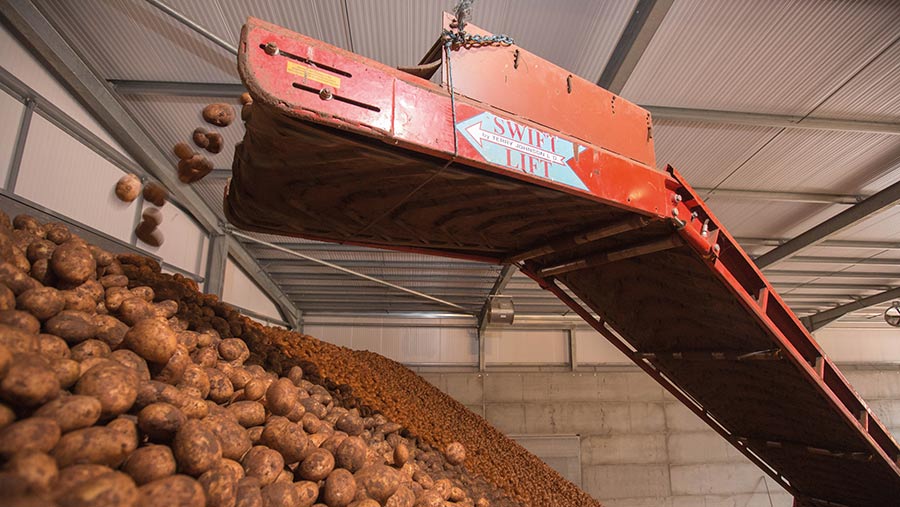Tips on how to reduce losses from tuber blight this autumn
 © Tim Scrivener
© Tim Scrivener Potato growers are urged to remain vigilant against tuber blight as the season draws to a close, with adequate skin set and early store management key to avoiding significant losses.
It has been a challenging year for late blight, particularly in East Anglia where disease pressure has been extremely high due to mild and humid conditions.
See also: Tips to minimise potato storage spoilage losses
While it hasn’t been unduly wet, unexpected showers have hindered spray programmes, called into question the adequacy of fungicides drying onto canopies before the next shower, or extended blight fungicide intervals past seven days.
Compounding matters is the aggressive 36_A2 blight strain, with samples sent to Fight Against Blight showing it to be responsible for some 90% of outbreaks in eastern England this year.
Norfolk-based independent potato specialist Simon Alexander says any blight patches found across his area have been where the weather has challenged the spray operator, with weather forecasting not helping matters.
Mr Alexander can’t think of a season where it has been more unreliable, with frequent unexpected dumps of rain across the region.
“If rain falls soon after spraying, you aren’t sure if the crop is well protected and there are cases where crops weren’t treated for a fortnight.
“Blight has also been more difficult to control in late-planted crops, which put on a spurt of fast, sensitive growth in late May and into early June. That tends to be where we’ve seen the worst problems,” he explains.
He adds that areas of poor application accuracy, such as around telegraph poles and in field corners, have also highlighted how important good spray coverage is to prevent blight outbreaks.
Tuber blight – key points
- Late blight pressure has been extreme in East Anglia, less in the North
- Potential for inoculum to infect tubers destined for store
- Check desiccated crops for regrowth and tidy up if found
- Ensure skin set is complete pre-harvest to reduce risk
- Identify potential problems with a sampling/hot box and store where easy to access
- Prioritise harvest risky stocks and cure, dry and cool crops in a timely fashion
Storage problems
With plenty of inoculum around, there is a concern that tuber blight – caused when late blight zoospores are washed into the tuber zone – might pose problems in store later this year.
Heavy rain this week (14 September) may aid movement of spores onto tubers, along with widespread reports of cracked ridges on more bodied soils.
It should also be noted that resistance to foliar and tuber blight in the same variety can be vastly different, so it shouldn’t be assumed a variety with high resistance to foliar blight won’t have infected tubers.
Mr Alexander says 60-70% of his processing crops destined for long-term storage have been desiccated and despite less-than-ideal conditions, flail and spray programmes have done a good job.
However, he says growers must remain vigilant against haulm regrowth, which can quickly provide a source of late blight inoculum with the potential to infect tubers.
“We’ve also seen a lot of alternative blight hosts such as hairy nightshade that have provided a source of infection. The desiccants should take them out, but it is something people should be aware of,” he explains.
In the north, Spud Agronomy’s John Sarup says pressure hasn’t been high all season, but the past six to eight weeks have seen disease pop up, with most outbreaks attributed to the aggressive 36_A2 and some the fluazinam-resistant 37_A2.
Programmes have contained tuber blight-active products such as Ranman Top (cyazofamid) and Infinito (fluopicolide + propamocarb hydrochloride) in late sprays during the flail and spray process and so far, he has seen no evidence of infected tubers.
However, the risk remains, and he says warm soils and tubers exacerbate it further during the run-up to harvest.
Skin set crucial
Mr Sarup stresses the importance of waiting for adequate skin set ahead of harvest, which can dramatically reduce the means of disease – and not only late blight – getting into tubers.
In the period between burndown and harvest, growers should also be taking a close look at samples taken during yield digs for any signs of tuber blight and manage any problem stocks accordingly.
“They need getting into store quickly to dry and cure with positive ventilation. During that time, take the field heat out of them steadily, too – refrigeration can help on drying and cooling where available.”
He adds that any risky stocks should also be located where they can be accessed easily, although this is sometimes difficult in bulk stores.
In Scotland, blight pressure in commercial crops has been nowhere near as problematic, with isolated issues occurring where programmes have been weak or spray timings missed, reports Scottish Agronomy’s Eric Anderson.
Minimise bruising
Many potato crops north of the border are showing high dry matter levels, so bruising at harvest is a significant threat.
Damage at harvest in turn leads to potential disease ingress into tubers, and high dry matter is something being seen in East Anglian crops by Mr Alexander too.
Mr Anderson says efforts should be made to keep harvester primary webs full of soil to cushion tubers. If soils remain dry, watering kits on the harvester will be useful to prevent gripping and scuffing of potatoes on haulm rollers.
“Warm and dry soils also bring the risk of dry rot (Fusarium spp), but if it turns wet then watery wound rot, pink rot and blackleg also come into the equation.
“Hot boxing samples every day during harvest will help identify problems and manage stocks accordingly as they go into store. It’s more straightforward here in Scotland, as all crops are harvested into boxes,” he adds.

